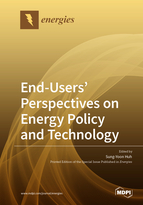End-Users’ Perspectives on Energy Policy and Technology
A special issue of Energies (ISSN 1996-1073). This special issue belongs to the section "C: Energy Economics and Policy".
Deadline for manuscript submissions: closed (31 October 2020) | Viewed by 30584
Special Issue Editor
Interests: energy and resource economics; energy demand analysis; economic valuation of energy project and technology; innovation diffusion; social acceptance; consumer preference
Special Issues, Collections and Topics in MDPI journals
Special Issue Information
Dear Colleagues,
The global energy market is changing rapidly, and a few megatrends can be identified in its transition. Among them, with a wider application of new energy technologies such as renewable energy, there is a possibility of shift from a conventional centralized energy supply system to a more distributed energy production system. In addition, as people’s overall economic level, education level, and living standards have improved, public interest and participation in energy policy and technology are steadily increasing. In many countries, the rejection of several energy projects due to the opposition of local residents is a representative example of such importance of public opinion in the process of energy policy implementation. In such a situation, it is very important to understand the social needs and public preferences for the energy policy and technology and reflect them fully in future energy policy and technology development. In this Special Issue, any kind of theoretical and empirical study that analyzes end users and general public’s perceptions and attitudes towards energy technology and policy would be welcomed.
The focus of this Special Issue is on (but is not limited to):
- Public preferences for and their attitude toward energy policy and technology;
- Social (local or nationwide) acceptance of issues in the field of energy;
- Impact of an energy policy on end-user behavior;
- Applications of stated preference methods to energy policy research;
- Valuation of novel energy technology and people’s willingness to pay for it;
- Identification of social needs for energy policy and/or technology.
Guest Editor
Manuscript Submission Information
Manuscripts should be submitted online at www.mdpi.com by registering and logging in to this website. Once you are registered, click here to go to the submission form. Manuscripts can be submitted until the deadline. All submissions that pass pre-check are peer-reviewed. Accepted papers will be published continuously in the journal (as soon as accepted) and will be listed together on the special issue website. Research articles, review articles as well as short communications are invited. For planned papers, a title and short abstract (about 100 words) can be sent to the Editorial Office for announcement on this website.
Submitted manuscripts should not have been published previously, nor be under consideration for publication elsewhere (except conference proceedings papers). All manuscripts are thoroughly refereed through a single-blind peer-review process. A guide for authors and other relevant information for submission of manuscripts is available on the Instructions for Authors page. Energies is an international peer-reviewed open access semimonthly journal published by MDPI.
Please visit the Instructions for Authors page before submitting a manuscript. The Article Processing Charge (APC) for publication in this open access journal is 2600 CHF (Swiss Francs). Submitted papers should be well formatted and use good English. Authors may use MDPI's English editing service prior to publication or during author revisions.
Keywords
- Social acceptance
- Public attitude and opinion
- Local acceptance
- Regional conflicts
- NIMBY
- PIMFY
- End-user preferences
- Distributed generation
- Decentralized energy system
- Energy prosumer
- Lay-people
- Community participation
- Economic valuation
- Willingness to pay
- Stated-preference techniques
- Survey






